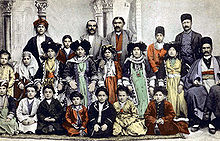
Back الآشوريون والسريان والكلدان في إيران Arabic آشوری ایرانلیلاری AZB Assyrer im Iran German آشوریان ایران Persian Assyriens en Iran French Ասորիներն Իրանում Armenian
ܐܬܘܪܝܐ ܕܐܝܼܪܵܢ (Syriac) | |
|---|---|
 Iranian Assyrians from Urmia, Iran | |
| Total population | |
| 20,000 [1] | |
| Regions with significant populations | |
| Languages | |
| Neo-Aramaic and Persian | |
| Religion | |
| Syriac Christianity |
Assyrians in Iran (Syriac: ܐܬܘܪܝܐ ܕܐܝܼܪܵܢ; Persian: آشوریان ایران), or Iranian Assyrians, are an ethnic and linguistic minority in present-day Iran. The Assyrians of Iran speak Assyrian Neo-Aramaic, a neo-Aramaic language descended from Classical Syriac and elements of Akkadian, and are Eastern Rite Christians belonging mostly to the Assyrian Church of the East and also to the Ancient Church of the East, Assyrian Pentecostal Church, Chaldean Catholic Church and Assyrian Evangelical Church.[2]
They share a common history and ethnic identity, rooted in shared linguistic, cultural and religious traditions, with Assyrians in Iraq, Assyrians in Turkey and Assyrians in Syria, as well as with the Assyrian diaspora.[2]
The Assyrian community in Iran numbered approximately 200,000 prior to the Islamic Revolution of 1979.[3] In 1987, there were an estimated 50,000 Assyrians living in Tehran.[4] However, after the revolution many Assyrians left the country, primarily for the United States; the 1996 Iranian census counted only 32,000 Assyrians.[5] Current estimates of the Assyrian population in Iran consist of 7,000 combined members of the Assyrian Church of the East and Chaldean Catholic Church in addition to less than 10,000 members of the Assyrian Evangelical Church.[6]
The Iranian capital, Tehran, is home to the majority of Iranian Assyrians; however, approximately 15,000 Assyrians reside in northern Iran, in Urmia and various Assyrian villages in the surrounding area.[2] To note among the Assyrian diaspora, the Assyrians residing in California and Russia tend to be originally from Iran.[7]
The Constitution of the Islamic Republic of Iran, ratified in 1979, recognizes Assyrians as a religious minority and ethnic minority and reserves for them one seat in the Islamic Consultative Assembly, the Iranian parliament.[8] As of 2004[update], the seat was occupied by Yonathan Betkolia, who was elected in 2000 and reelected in the 2004 legislative election.[citation needed]
In 2010, it was estimated that there were only around 5,000 Assyrians left in the historical center of the city of Urmia.[9]
- ^ "Iran". U.S. Department of State 2018 Report on International Religious Freedom: Iran.
- ^ a b c Hooglund (2008), pp. 100–101.
- ^ "Iran: Assyrian Policy Institute". Assyrian Policy Institute. Retrieved July 29, 2020.
- ^ "ASSYRIANS IN IRAN i. The Assyrian community ( – Encyclopaedia Iranica". www.iranicaonline.org. Retrieved 2020-05-20.
- ^ Hooglund (2008), pp. 100–101, 295.
- ^ "Iran". United States Department of State. Retrieved 2020-05-20.
- ^ Nisan, Mordechai (2015). Minorities in the Middle East: A History of Struggle and Self-Expression, 2d ed. McFarland. p. 191. ISBN 9780786451333.
- ^ Hooglund (2008), pp. 128–129.
- ^ Nicholas al-Jeloo, Evidence in Stone and Wood: The Assyrian/Syriac History and Heritage of the Urmia Region in Iran. Parole de l'Orient 35 (2010), pp. 1-15.
© MMXXIII Rich X Search. We shall prevail. All rights reserved. Rich X Search